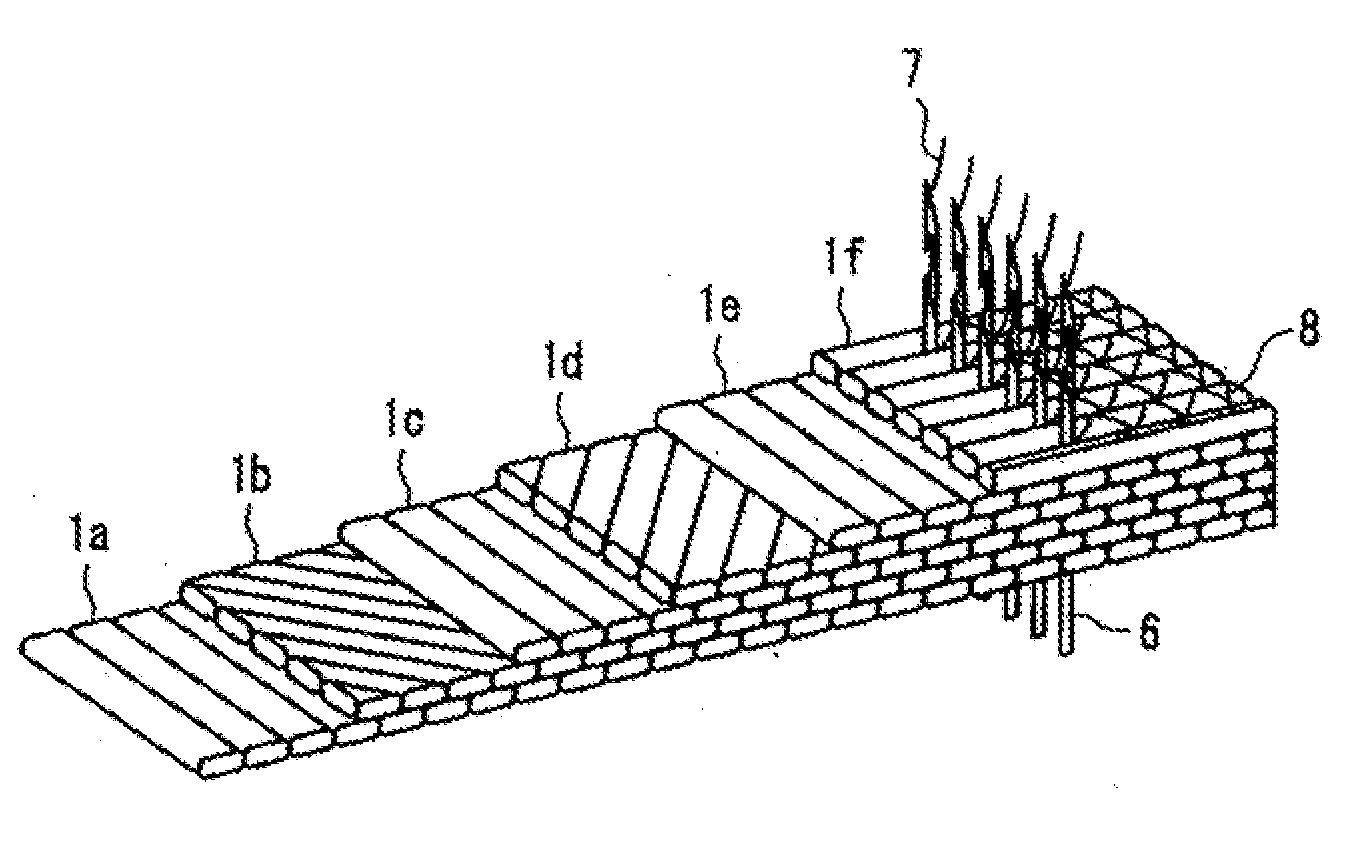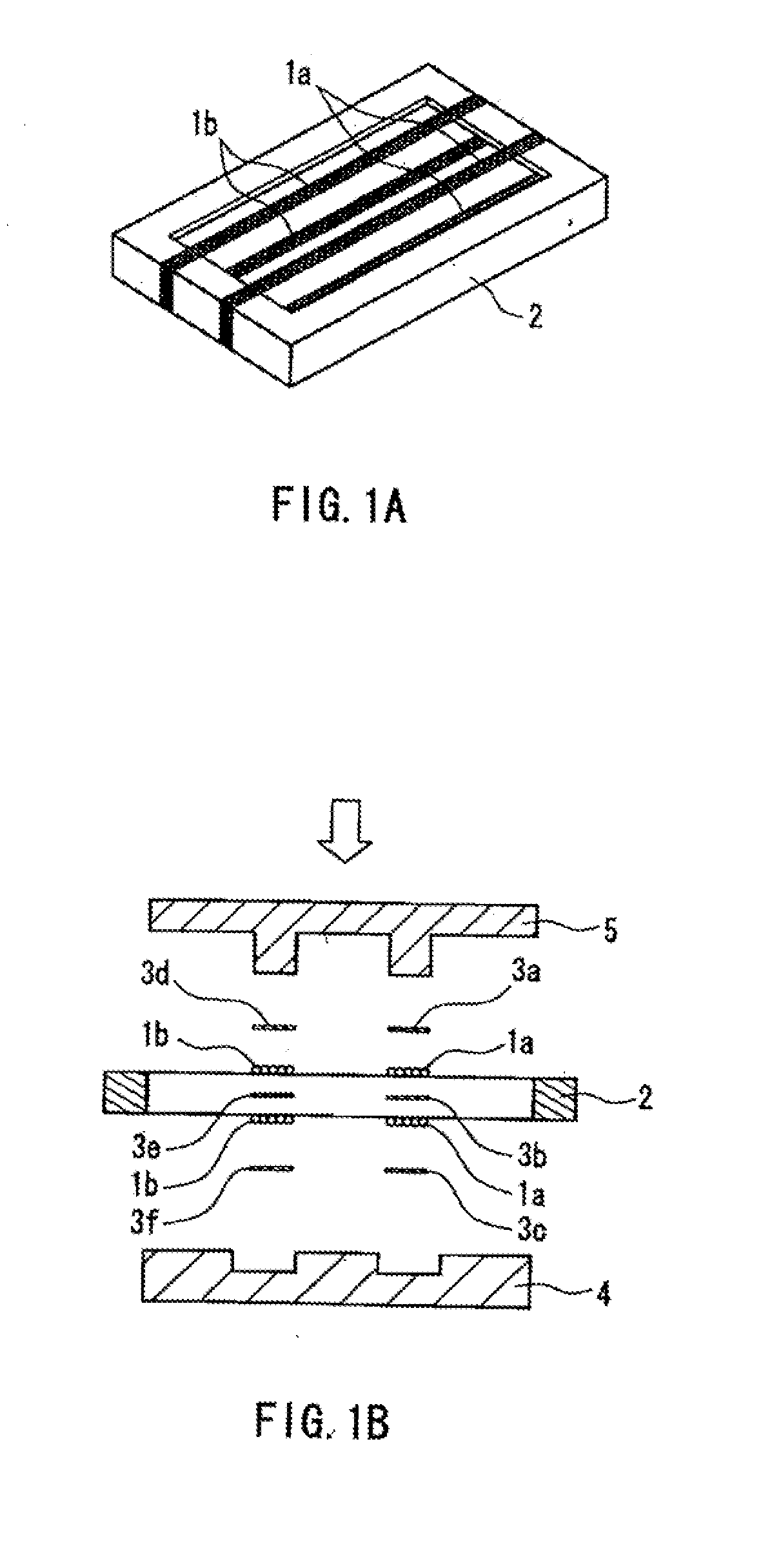Fiber reinforced thermoplastic resin molding
a thermoplastic resin and fiber technology, applied in lamination, thin material processing, layered products, etc., can solve the problems of carbon fiber, shorten the life of incinerators, and insufficient strength of plastics alone, and achieve the effect of uniform physical properties and high strength
- Summary
- Abstract
- Description
- Claims
- Application Information
AI Technical Summary
Benefits of technology
Problems solved by technology
Method used
Image
Examples
example 1
[0023]FIG. 1A is a plan view showing a method of manufacturing a molding according to one example of the present invention by using a film-stacking method. FIG. 1B is a cross-sectional view showing the manufacturing method. Spun yarns la and lb made of flax (linen) fiber were wound around a metal frame 2 in one direction as shown in FIG. 1A. The 132 spun yarns, each having a thickness (fineness) of 130 tex, were wound over a width of 20 mm, which had a weight of 3.1 g. As shown in FIG. 1A, the spun yarns were wound around the metal frame 2 at two places with a certain distance therebetween. Each of the spun yarns had 12 turns per inch (472.4 T / m) and a decomposition temperature of about 200° C. As shown in FIG. 1B, polypropylene (PP) films 3a to 3f, each having a melting point of 151° C. and a thickness of 0.2 mm (200 μm), were disposed on both surfaces of the wound spun yarns and therebetween (between the upper and lower yarn surfaces), and the flax (linen) spun yarns and the PP fi...
example 2
[0027]Next, the effect of moisture was examined. Since natural fiber is highly absorptive, it changes greatly in dynamical physical property due to moisture. Further, it is thought that the existence of moisture during molding results in a nonimpregnated region. Thus, conventionally, the existence of moisture has been considered unfavorable.
[0028]First, samples of flax spun yarn alone having different moisture regains were formed under the following conditions.[0029](1) Drying: performed at 60° C. for 24 hours[0030](2) Equilibrium moisture regain: left to stand in an indoor environment at 25° C. and at 65% relative humidity; state of having an equilibrium moisture regain[0031](3) Water absorption: performed at 80° C. in saturated water vapor for 120 hours
[0032]The physical property of each of the samples is shown in Table 2.
TABLE 2ElasticMoisturemodulusStrengthregainState(GPa)(GPa)(%)Dried23.14200Equilibrium23.95004.4moisture regainWater absorbed20.5620115.8
[0033]As shown in Table 2...
application example
[0042]An application example of the present invention is shown in FIG. 3. FIG. 3 is a schematic perspective view of a multiaxial warp knitted fabric. Flax spun yarns 1a to 1f arranged in a plurality of directions were stitched (bound) with stitching yarns 7 and 8 that pass through needles 6, in a thickness direction into a single unit. Such a multiaxial warp knitted fabric can be used as a fiber reinforcing material to be molded integrally with a thermoplastic resin.
PUM
| Property | Measurement | Unit |
|---|---|---|
| temperature | aaaaa | aaaaa |
| decomposition temperature | aaaaa | aaaaa |
| weight | aaaaa | aaaaa |
Abstract
Description
Claims
Application Information
 Login to View More
Login to View More - R&D
- Intellectual Property
- Life Sciences
- Materials
- Tech Scout
- Unparalleled Data Quality
- Higher Quality Content
- 60% Fewer Hallucinations
Browse by: Latest US Patents, China's latest patents, Technical Efficacy Thesaurus, Application Domain, Technology Topic, Popular Technical Reports.
© 2025 PatSnap. All rights reserved.Legal|Privacy policy|Modern Slavery Act Transparency Statement|Sitemap|About US| Contact US: help@patsnap.com



